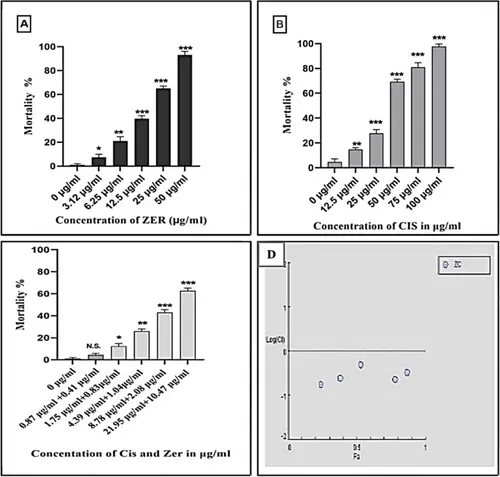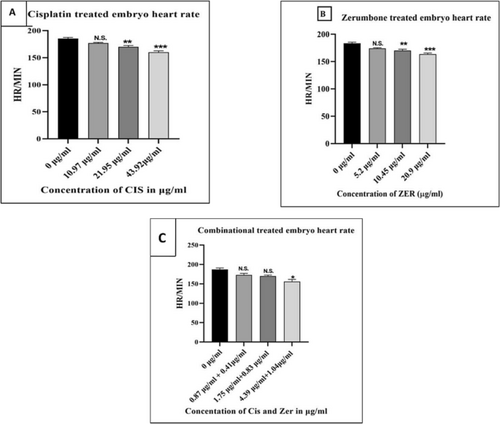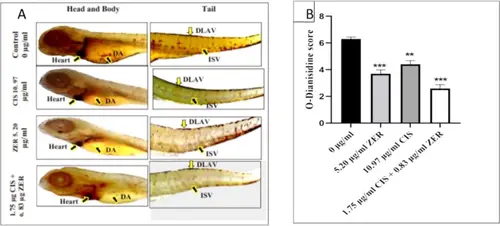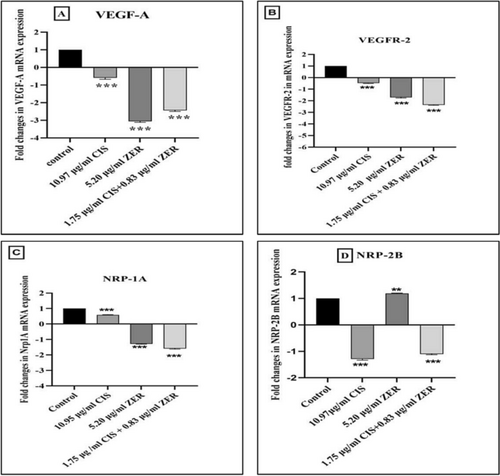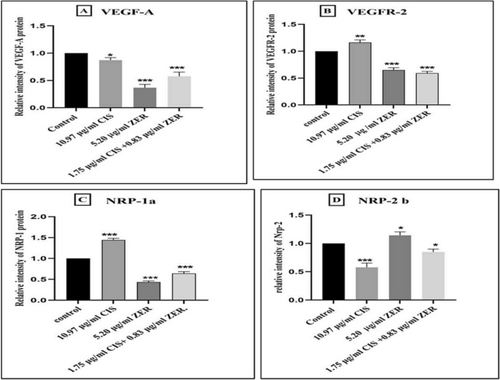- Title
-
Evaluation of synergistic effect of Zerumbone with Cisplatin on anti-angiogenic potential in zebrafish model
- Authors
- Haripriya, D., Devi, J.S., Santhosh, A., Bupesh, G., Phukan, M.M., Panigrahi, J., Deb, C.R., Mathyazhagan, M., Kirubakaran, D., Saravanan, K.M., Padmanabhan, P., Mathe, D., Archunan, G.
- Source
- Full text @ Med Oncol
|
Effect of CIS, ZER, and Combination treatment on mortality at 96hpf and combination index plot to predict effect of drug in Zebra fish model. A–C indicates the acute toxicity of CIS, ZER, and Combinational dose in zebra fish larvae, dose dependent increase in mortality was observed irrespective of the treated groups compared to control, LC50 value of CIS and ZER was found to be 43.970 μg/ml CIS, 20.83 μg/ml ZER. In combination treated larvae only 25%, 10% mortality was observed at highest concentration. D Combination index value was calculated through Compu-Syn software (1.0), in accordance to the Chou and Talalay (1984) method. CI reaction was obtained by plotting the fraction affected (fa) against the CI plot to predict synergistic, agonistic and antagonistic effects of the drug in zebra fish model |
|
Heart rate of zebra fish larvae treated with CIS, ZER, and Combination dose. A–C reveals that in CIS, ZER, and combination dose treated larvae, moderate (p < o.o5) and minimum (p < 0.01) reduction in heart beat rate was observed in a dose-dependent fashion with the maximal decrease occurring at the highest dose. Nevertheless, there was no marked difference in the rate of heartbeat among the treatment groups |
|
Effect of CIS, ZER, and Combination dose on malformations in zebra fish at 24, 48, and 72 hpf. Note the deformities in body development at 24 h, 48 h, 72 h in larvae exposed to the CIS (10.92 μg/ml) and ZER (5.20 μg/ml) displaying malformations such as kinked tail, bent trunk, body curvature, and pericardial edema and incomplete yolk sac absorption. The deformities observed in CIS alone exposed group remained persistent even at 72hpf. Most of the abnormalities were prevented in CIS + ZER treated group |
|
Pictorial and Graphical representation of anti-angiogenic effect of CIS, ZER, and Combination. A The larvae were exposed to CIS, ZER, and their Combination dose stained at 72 hpf with O-dianisidine staining to detect RBCs in specific areas such as dorsal aorta (DA), inter-segmental vessels (ISV), dorsal longitudinal anastomotic vessel (DLSV), and posterior cardinal vein (PCV). Note the greatest decrease in RBC stained cells in combination treated larvae than individually ZER and CIS treated larvae. B Graphical representation indicates that in ZER and Combination treated larvae O–Dianisidine score is extremely significant (p < 0.001) than CIS treated larvae |
|
Anti-angiogenic effects of CIS, ZER, and their Combination dose on VEGF- A, VEGFR-2, NRP- 1A, NRP- 2B gene expression in zebrafish larvae. A indicates the down-regulated VEGF-A mRNA expression, irrespective of the treatment groups. Maximal down-regulation was observed in zebra fish undergone ZER treatment. B states the subnormal down-regulation of VEGFR-2 mRNA expression in ZER and combination treatment groups than CIS alone treated larvae. C Note the moderate significant (p < 0.001), reduction in NRP-1A mRNA expression in ZER, and combination treatment, whereas in CIS treatment mild significant decrease in NRP-1A gene expression was observed. D illustrates the significant down-regulation of NRP-2B gene expression in CIS, and combination treated group. Comparatively, the effect on NRP-2B gene expression was highly up-regulated in the ZER treated group |
|
Western blot images showing angiogenic protein (VEGF-A, VEGFR-2, NRP-1A, NRP-2B expression with β actins in Zebra fish larvae. Pictorial representation of the blot images indicates that in (A). Note the consistent reduction of VEGF–A protein expression, irrespective of the treatment groups. B indicates the marginal increase in the expression of VEGFR-2 in CIS alone treated group, while ZER either alone or in combination with CIS reduced the expression of VEGFR-2 expression. C Note the marginal increase in the Nrp-1A expression in CIS alone treated group, while ZER alone or combination dose down-regulated the Nrp-1A expression. D reveals that Nrp-2B expression is reduced in CIS treated group, while ZER and combination treatment caused a mild increase in Nrp-2B expression. E shows the β—Actin protein expression was increased in control and in treated larvae |
|
Graphical representation of relative levels of (VEGF-A, VEGFR-2, NRP-1A, NRP-2B) protein expression in Zebra fish larvae. A illustrates the extreme significant (p < 0.001) reduction of VEGF-A protein expression in ZER and Combination dose than CIS treated larvae. B states the marginal significant increase (p < 0.05) of VEGFR-2 in CIS treated group, while ZER alone or in combination dose, VEGFR-2 expression is highly reduced by significant fold change. C Note the moderate increase by (1.47 fold) in the Nrp-1 A expression in CIS alone treated group, while ZER alone or combination dose,the Nrp-1A expression is significantly down-regulated by (0.41 fold), (0.62 fold). D Note the extreme significant reduction (p < 0.001) in the Nrp-2B expression in CIS treated group, while ZER alone or combination treatment caused a marginal increase (p < 0.01) in Nrp-2 B expression |

